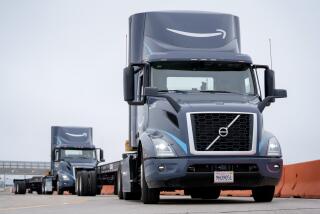
- Share via
- New sales figures from the dealers trade group show 387,368 zero-emission vehicles were registered in California in 2024, or roughly one out of four new cars sold.
- That represents just a 1% increase over previous year figures, when EV sales soared 46%. Total California new car sales for 2024 were also flat, at 1.75 million vehicles.
Demand for new electric vehicles has flatlined in California, new sales figures show, raising questions as to whether automobile manufacturers can meet ambitious state mandates for zero-emission vehicle sales.
Aside from Tesla, which sells only EVs, no other major manufacturer will meet the state’s 35% threshold for zero-emission vehicles in the upcoming 2026 model year, said Brian Maas, president of the California New Car Dealers Assn.
“The data don’t lie,” Maas said. “The demand doesn’t match what the mandate requires. It’s just that simple.”
New sales figures from the dealers trade group show 387,368 zero-emission vehicles were registered in California in 2024, or roughly one out of four new cars sold.
Even so, that represents just a 1% increase over previous year figures, when EV sales soared 46%. Total California new car sales for 2024 were also flat, at 1.75 million vehicles.
There are potentially severe implications for automakers. Failing to meet the 35% mandate, according to Maas, means either paying penalties of $20,000 for every noncompliant vehicle sold, or restricting gasoline and diesel inventory in California so the percentage can be met.
Automakers can also reduce fines by buying state-issued emission credits from automakers who hold a surplus of them. The vast majority are held by Tesla.
Automakers “won’t pay the fines,” Maas said, but instead will opt for inventory control — for example, limiting sales of gas- and diesel-powered pickup trucks.
“Arizona and Nevada dealers could be flooded with internal combustion vehicles,” he said, while Californians struggle to find the car they want. And, he said, California prices would likely rise.
Maas said his group has begun pushing for a pause in the mandate. Asked for a response, Gov. Gavin Newsom’s office had no comment, but deferred to state agency spokespeople.
The California Energy Commission said it remains “committed to helping transform the market and confident in our ability to deliver cleaner air to all Californians.”
“California is proud to lead the country in zero-emission vehicle sales as the global market continues to innovate and surge,” the statement said. “The rapid pace of EV adoption worldwide has become a building block of a new industrial policy that is shaping California’s future economy with more than 50 manufacturers of zero-emission vehicle components calling our state home.”
The California Air Resources Board said it’s “premature to say the target will not be met and that manufacturers planning is inadequate to continue to grow the market. Yes, some may need to buy credits, but that’s always been an option to provide manufacturer flexibility.”
The state mandate comes in the form of a program called Advanced Clean Cars II, run by the California Air Resources Board. Crucially, the rules require automakers to sell EVs, but do not require consumers to buy them. Newsom announced the EV phaseout in 2020. The state Air Resources Board set the rules in 2022, and in December, the Biden administration approved a waiver allowing the state to set the standards, as required under the federal Clean Air Act.
But flagging consumer interest has caused automakers to pull back on their EV ambitions. While declaring commitment to the EV market, major automakers have been canceling some EV projects and extending timelines for others, and pulling out of deals to build battery factories in the U.S.
Japanese car companies, which were slow to move into the EV market, are suddenly on a roll with their hybrid cars, which posted a 32% gain in California sales for 2024, and a total market share increase from 11.1% to 14.7%. (Plug-in hybrids, which the state includes in its definition of zero-emission vehicles, even though they are equipped with an internal combustion engine, posted virtually flat sales: 60,800 cars and light trucks in 2024, up from 59,506.)
Elon Musk’s Tesla was hit especially hard in California last year, with an 11.6% drop in new car registrations, to 203,221 cars. Tesla remains by far the state’s EV market share leader, with 52.5% of the new car market, but that dropped 7.6 points from 60.1%.
Industry analysts say several factors may be behind Tesla’s decline in sales growth here, including lack of new models, increased competition from other automakers and displeasure among liberals with Musk’s emergence as a key ally of President Trump.
Whatever the reason, Tesla’s once-brilliant California star is beginning to fade. Rivian has emerged as a strong Tesla competitor, with 2024 California sales up 17%, albeit from a small base — in 2024, it sold 10,277 vehicles in California.
Even if Tesla sales continue to fall, though, the company could still score big from lagging EV sales because of state policies that intentionally favor Tesla over traditional automakers under state regulations intended to punish sales of gasoline cars. Tesla has earned billions in profit over the years by selling state-issued emission credits.







